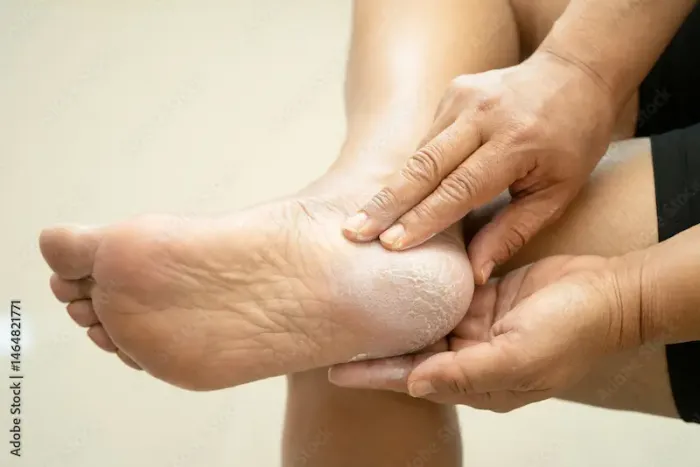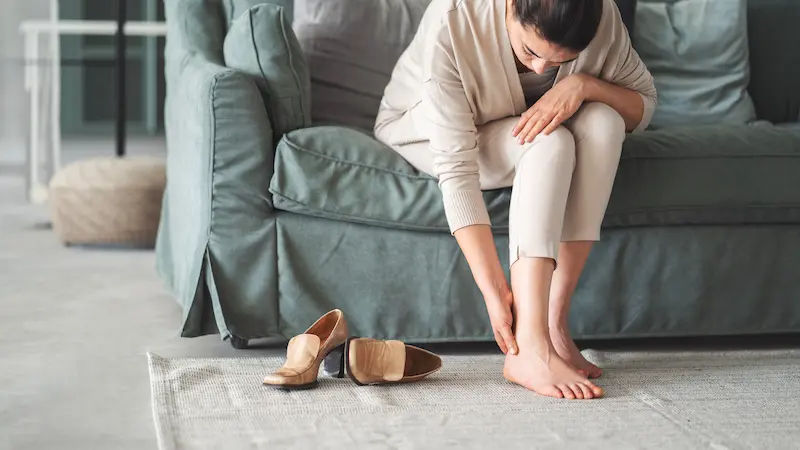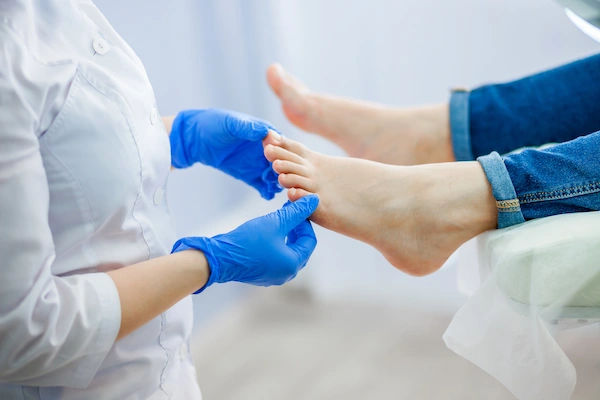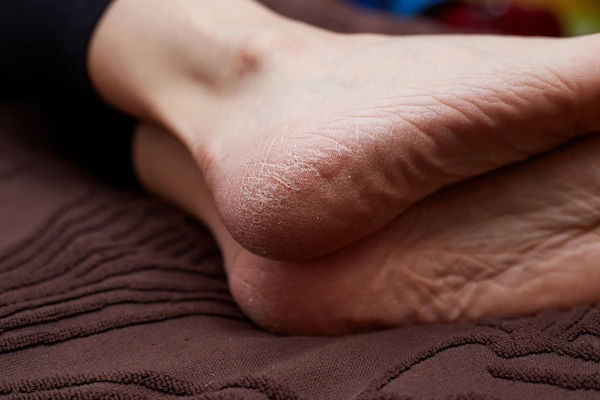Cracked Feet Causes, Fixes And Prevention Guide
Learn what causes cracked feet, how to treat them effectively, and practical tips to prevent dryness and discomfort for healthy, smooth feet.


Introduction
Cracked feet can turn every step into a wince. If your heels feel rough, snag on socks, or even split and bleed, you’re not alone—dry skin, pressure, and everyday habits can set the stage for painful fissures. The good news? With the right routine and a few smart product choices, most people can heal cracked feet at home within a couple of weeks. In this guide, we’ll explain why feet crack in the first place, how to tell when it’s more than simple dryness, and the exact step-by-step routine dermatologists and podiatrists recommend. You’ll learn which ingredients actually work (think urea and lactic acid), when to change your shoes or socks, and how to prevent cracks from coming back. We’ll also cover special tips if you have diabetes, stand all day, or live in a dry climate, and we’ll point to signs that mean it’s time to see a doctor. Ready to get comfortable on your feet again? Let’s start with what’s really going on inside those dry, splitting heels.
What Are Cracked Feet?
Cracked feet, often called heel fissures, are splits that form in the thick skin (callus) around the heels and occasionally the forefoot. They happen when the skin becomes too dry and thick, then flexes under body weight and pressure. The edges of the callus can separate like a fault line, creating cracks that range from hairline to deep, sometimes bleeding fissures that make standing painful.
How cracks form in the skin barrier?
• Your skin barrier is like a brick wall: corneocytes (bricks) held together by lipids (mortar). Low humidity, hot showers, harsh soaps, and friction strip that “mortar,” making the wall brittle.
• When thickened heel skin bends under pressure (walking, standing), the dry callus can split, especially at the posterolateral heel where pressure peaks occur.
Signs and symptoms to watch for
• Dry, rough, or scaly skin on the heels
• Yellowish callus with fine lines progressing to visible splits
• Pain when walking barefoot or in open-back shoes; occasional bleeding
• White, soggy skin in the cracks after showering (a setup for infection)
How cracked heels differ from athlete’s foot or eczema
• Athlete’s foot (tinea pedis) often begins between toes with itch, scaling, and sometimes blisters; it can extend to heels but usually shows “moccasin” scaling around the sole and edges, not isolated deep heel cracks.
• Eczema/psoriasis can cause red, inflamed plaques elsewhere on the body; heel fissures from these conditions usually occur alongside other classic patches or nail changes. If you’re unsure, a clinician can help distinguish them.
Consult Top Specialists
Why Do Feet Crack? Root Causes You Can Address
Dry skin is the “fuel,” pressure is the “spark,” and certain habits are the “wind” that fans the flames. Addressing each lever yields the fastest results.
Dry skin (xerosis), cold/dry weather, and hot showers
• Low humidity, air conditioning or heating, and frequent hot baths strip moisture and lipids from the skin barrier, making heels brittle.
• Many body washes contain fragrances and surfactants that further dry the skin on your feet. Switching to a gentle, fragrance-free cleanser can help.
Biomechanics: pressure, open-back shoes, prolonged standing
• Open-back shoes (sandals, slides) allow the heel fat pad to splay outwards with each step, increasing shear forces on the skin and encouraging fissures.
• Standing on hard floors for long shifts increases pressure points; obesity adds load. Even small changes like cushioned insoles and closed-back shoes can reduce strain on the heel edge.
• Tight Achilles tendon or altered gait can shift pressure to the posterior-lateral heel, a common cracking site. A podiatrist can assess this if cracks keep recurring.
Skin conditions and infections that mimic or worsen cracks
• Eczema, psoriasis, and ichthyosis can predispose to thick, dry, fissured skin.
• Athlete’s foot can make skin scaly and prone to cracking; antifungal treatment is necessary in those cases.
• Hypothyroidism and diabetic neuropathy/circulatory issues impair skin repair and moisture, increasing risk.
Who’s Most at Risk
Diabetes, neuropathy, and poor circulation
• People with diabetes often have drier skin and may not feel pain from cracks due to neuropathy, allowing fissures to deepen and sometimes get infected.
• Poor blood flow can slow healing. Pain, redness, warmth, swelling, or discharge are urgent warning signs.
Older adults and post-menopausal skin changes
• With age, skin produces fewer lipids and natural moisturising factors; the heel pad also thins and spreads differently under load, increasing mechanical stress.
• Post-menopausal hormonal shifts can exacerbate dryness at the feet.
Atopic dermatitis, psoriasis, hypothyroidism, and obesity
• These common conditions amplify dryness and thickness of skin, making fissures more likely.
• Obesity increases load across the heel with every step; even a small amount of body-weight reduction can reduce pressure.
Quick Self-Check: Severity and Red Flags
Minor dryness vs deep, painful fissures
• Hydrated-after-shower skin that looks smooth but feels rough dry later = mild xerosis.
• Visible yellow callus with shallow cracks = moderate fissuring; good candidate for home care.
• Deep, painful, or bleeding cracks that catch on socks/shoes = severe; consider medical care.
Signs of infection or ulceration
• Redness spreading from a crack, warmth, swelling, pus, bad odour, fever, or streaking up the leg are red flags that warrant urgent care.
• People with diabetes should treat any fissure with caution and lower threshold for professional review.
When to get professional help
• If there’s no improvement after 14 days of diligent home care; if fissures are deep, bleeding, or extremely painful; or if you have diabetes or poor circulation. If symptoms persist beyond two weeks, consult a doctor online with Apollo 24|7 for further evaluation. If your condition does not improve after trying these methods, book a physical visit to a doctor with Apollo 24|7.
Consult Top Specialists
At-Home Care That Works: A Step-by-Step Routine
Soak, soften, and gently reduce thick skin
• Frequency: 3–4 times per week initially.
• Soak: 10 minutes in lukewarm water (not hot) with a gentle, fragrance-free cleanser. Avoid harsh foot soaks that over-macerate the skin.
• Reduce thickness: After soaking, pat dry and use a pumice stone or a fine foot file to gently smooth the thickened callus. Do not use blades or razors—these increase risk of cuts and infection.
The “seal” step: occlusives and socks overnight
• Apply a keratolytic cream with urea (10–25% for daily use; up to 40% short-term under clinician guidance), lactic acid (5–12%), or salicylic acid (2–6%) to soften and dissolve thick skin.
• Seal with an occlusive like petrolatum or a thick balm; then wear cotton socks overnight to enhance penetration (“occlusive booties”). This “soften and seal” combo is the cornerstone for how to heal cracked feet fast.
A 14-day plan and what improvement looks like
• Days 1–3: Daily moisturization twice a day; soak–file–seal every other day.
• Days 4–10: Continue keratolytic nightly; gentle filing 2–3 times/week. You should see fewer snags on socks, shallower cracks, and less tenderness.
• Days 11–14: Transition to maintenance if cracks are largely closed; if still deep/painful, seek care.
Ingredients That Heal: What to Look For (and Avoid)
Urea (10–40%), lactic acid, salicylic acid: how they help
• Urea is both a humectant and a keratolytic: it draws water into skin and breaks down hardened protein bonds. Creams in the 10–25% range are effective for daily use; 30–40% can be used short-term for thicker callus under clinical advice.
• Lactic acid and salicylic acid help dissolve dead skin and smooth fissure edges; choose concentrations appropriate for sensitive skin, especially if inflamed.
Petrolatum, glycerin, ceramides: barrier repair and humectants
• Petrolatum forms a protective seal that reduces water loss.
• Glycerin is a powerful water-attracting humectant.
• Ceramides help restore the “mortar” in your skin barrier, improving flexibility and resilience.
What to avoid: harsh scrubs, blades, and fragranced products
• Harsh mechanical scrubs and metal razors can tear skin and trigger more cracking.
• Fragrances and certain essential oils can irritate fissured skin and sting on application. Look for “fragrance-free” (not just “unscented”).
Medical Treatments and When to See a Doctor
Prescription-strength keratolytics and topical steroids (if inflamed)
• Your clinician may prescribe higher-strength urea, lactic acid, or salicylic formulations, or a short course of a low-potency topical steroid if the surrounding skin is inflamed from eczema/psoriasis.
• If fungal infection is present (athlete’s foot), an antifungal cream is needed; cracks won’t heal if fungus persists.
Tissue adhesive for deep fissures and professional debridement
• For deep, painful fissures, clinicians sometimes apply medical-grade tissue adhesive to “close” the crack temporarily, relieve pain, and allow healing, along with careful debridement of thick callus.
• Podiatrists can pare thick calluses safely and advise on biomechanical contributors (orthotics, stretching routines).
Lab tests and imaging in complex cases
• If healing is unusually slow or there are recurrent infections, clinicians may check for diabetes (HbA1c), thyroid issues (TSH), or nutritional deficiencies (e.g., vitamin D). Apollo 24|7 offers convenient home collection for tests like vitamin D or HbA1c.
• Imaging is rarely needed unless there’s concern for deeper infection or ulceration (more common in advanced diabetes).
Footwear, Insoles, and Lifestyle Fixes
Closed-back shoes and cushioning
• Choose closed-back shoes that support the heel and limit fat pad splaying. A slight heel drop and cushioning at the heel can reduce shear forces.
• Avoid thin, flat flip-flops and backless sandals during healing, even indoors.
Moisture-wicking socks and seasonal strategies
• Moisture-wicking cotton or wool-blend socks help manage sweat without drying skin. In winter, increase moisturiser frequency; in summer, mind open-back shoes and pool decks.
• Consider silicone heel sleeves at night to enhance hydration.
Workplace routines for long hours on your feet
• If you stand all day, rotate shoes every other day, use anti-fatigue mats, and take micro-breaks to sit and stretch calves and arches.
Common Mistakes to Avoid
Over-filing, sharp tools, and foot peels gone wrong
• Heavy-handed filing or acid peels can overshoot, causing rawness and rebound thickening. Gentle and gradual wins.
Skipping moisturisers after bathing
• The “golden minute” after a shower is the best time to trap water in your skin. Keep a foot cream by the towel rack.
Pedicure pitfalls and hygiene
• Avoid whirlpool footbaths with questionable hygiene. Do not let anyone use a razor on your feet. Bring your own tools if possible, and ensure proper disinfection.
Natural and Home Remedies: What’s Worth Trying?
Epsom salts, honey, and oils—what evidence says
• Epsom salt soaks can feel soothing but don’t directly “heal” cracks; avoid prolonged soaking that macerates skin.
• Occlusive oils (like petrolatum or plain mineral oil) help seal moisture; plant oils vary—some can irritate; patch test first.
• Honey has mild antimicrobial and humectant properties, but evidence for heel fissures is limited. Use as an adjunct, not a primary therapy.
Occlusive “booties” and plastic wrap (safe use)
• For very dry feet, apply cream and cover with a thin plastic wrap under socks for 30–60 minutes (not overnight) a few times per week to boost absorption. Avoid if there’s infection or open, bleeding cracks.
Building a Prevention Habit that Sticks
A weekly maintenance plan
• Once healed, file lightly once a week after a short soak, moisturise nightly with a urea or lactic acid cream, and seal with petrolatum when needed.
Travel and gym hygiene tips
• Wear flip-flops in communal showers to avoid athlete’s foot; moisturise after swimming; avoid walking barefoot on abrasive surfaces.
Tracking triggers and progress with phone photos
• Snap quick heel shots every week to spot early thickening and intervene before cracks form. Note seasonal changes, new shoes, or job shifts.
Consult Top Specialists
When Cracked Feet Signal Something More
Differentials: athlete’s foot, eczema, psoriasis
• Persistent scaling around edges of the sole (moccasin distribution) or itch between toes suggests tinea pedis; treat with antifungals. Inflamed plaques elsewhere point toward eczema or psoriasis.
Clues from your nails, gait, and posture
• Thickened, discoloured toenails may indicate fungal nails; altered gait or calf tightness shifts pressure to the heel. A podiatrist or physiotherapist can help address root biomechanics.
Cost-Savvy Care: Budget vs Premium Options
What to prioritise if you’re on a budget
• Essentials: a fragrance-free urea or lactic acid foot cream, petrolatum jelly, a pumice or fine file, and cotton socks. These alone can deliver excellent results.
Smart splurges that make a difference
• Silicone heel sleeves, custom insoles if you stand all day, and a high-quality closed-back shoe you actually like wearing. These reduce mechanical stress so results last.
Conclusion
Painful, cracked feet aren’t just a cosmetic issue—they’re a signal that your skin barrier needs support and your heels are shouldering extra stress. By pairing barrier repair (urea or lactic acid plus a sealing ointment) with mechanical changes (closed-back cushioned shoes, moisture-wicking socks), you address both sides of the problem. A simple 14-day routine—soak, smooth, seal—helps most people see real improvements quickly, while ongoing weekly maintenance keeps heels soft and resilient. If you have diabetes or circulation problems, treat cracks with extra caution and seek help early to avoid complications. And remember, not all “foot dryness” is the same: if you’re seeing scaling around the edges of your feet or itching between toes, consider athlete’s foot; if inflamed plaques are present elsewhere, eczema or psoriasis could be in play. When in doubt—or if your cracks are deep, bleeding, or not improving—it’s wise to get professional guidance. If symptoms persist beyond two weeks, consult a doctor online with Apollo 24|7 for further evaluation, or book a physical visit. If your clinician advises, Apollo 24|7 also offers home collection for tests like HbA1c or vitamin D that can influence skin healing. With consistent care and a few smart choices, you can get back to comfortable, confident steps—no snagging socks required.
Consult Top Specialists

Dr. Aishwarya Malladi
Dermatologist
3 Years • MBBS, MD (Dermatology)
Chinagadila
Apollo Hospitals Health City Unit, Chinagadila
(100+ Patients)

Dr. Anushtha Tomar
Dermatologist
10 Years • Md( Dermatology, Venereology, Leprosy )
Indore
Apollo Hospitals Vijay Nagar, Indore

Dr. Surendra V H H
Dermatologist
40 Years • MBBS, DVD, MD
Bengaluru
Apollo Hospitals Jayanagar, Bengaluru
(75+ Patients)

Dr. K Chetana
Dermatologist
10 Years • MBBS, MD ( Dermatology)
Hyderabad
Apollo 24|7 Clinic, Hyderabad

Dr. Pranoti Deshpande
Dermatologist
5 Years • MBBS, MD (Dermatology, Venereology and Leprosy)
Hyderabad
Apollo Hospitals D R D O kanchanbagh, Hyderabad
(175+ Patients)
Consult Top Specialists

Dr. Aishwarya Malladi
Dermatologist
3 Years • MBBS, MD (Dermatology)
Chinagadila
Apollo Hospitals Health City Unit, Chinagadila
(100+ Patients)

Dr. Anushtha Tomar
Dermatologist
10 Years • Md( Dermatology, Venereology, Leprosy )
Indore
Apollo Hospitals Vijay Nagar, Indore

Dr. Surendra V H H
Dermatologist
40 Years • MBBS, DVD, MD
Bengaluru
Apollo Hospitals Jayanagar, Bengaluru
(75+ Patients)

Dr. K Chetana
Dermatologist
10 Years • MBBS, MD ( Dermatology)
Hyderabad
Apollo 24|7 Clinic, Hyderabad

Dr. Pranoti Deshpande
Dermatologist
5 Years • MBBS, MD (Dermatology, Venereology and Leprosy)
Hyderabad
Apollo Hospitals D R D O kanchanbagh, Hyderabad
(175+ Patients)
Consult Top Specialists

Dr. Aishwarya Malladi
Dermatologist
3 Years • MBBS, MD (Dermatology)
Chinagadila
Apollo Hospitals Health City Unit, Chinagadila
(100+ Patients)

Dr. Anushtha Tomar
Dermatologist
10 Years • Md( Dermatology, Venereology, Leprosy )
Indore
Apollo Hospitals Vijay Nagar, Indore

Dr. Surendra V H H
Dermatologist
40 Years • MBBS, DVD, MD
Bengaluru
Apollo Hospitals Jayanagar, Bengaluru
(75+ Patients)

Dr. K Chetana
Dermatologist
10 Years • MBBS, MD ( Dermatology)
Hyderabad
Apollo 24|7 Clinic, Hyderabad

Dr. Pranoti Deshpande
Dermatologist
5 Years • MBBS, MD (Dermatology, Venereology and Leprosy)
Hyderabad
Apollo Hospitals D R D O kanchanbagh, Hyderabad
(175+ Patients)
More articles from Foot Cracks
Frequently Asked Questions
1) What is the best cream for cracked feet?
Look for a urea cream for feet (10–25%) or a lactic acid foot moisturiser. Apply nightly and seal with petrolatum for faster results.
2) How to heal cracked feet fast at home?
Use the soak–smooth–seal routine: short lukewarm soak, gentle pumice, urea/lactic acid cream, then petrolatum and socks overnight. Most see improvement within 1–2 weeks.
3) When should I see a podiatrist for cracked heels?
If cracks are deep, bleeding, very painful, or not improving after 14 days of diligent care—or if you have diabetes or poor circulation—see a clinician. You can start with an online consult via Apollo 24|7.
4) Are foot peels safe for cracked heels?
Strong acid peels can over-exfoliate and worsen fissures. For deep cracks, stick with gentle filing plus urea/lactic creams; consider professional care for severe cases.
5) What’s the difference between dry, cracked feet and athlete’s foot?
Cracked heels are often localised to the heel with thick callus. Athlete’s foot commonly causes itch and scaling between toes or a “moccasin” pattern around the sole. If you suspect fungus, use an antifungal and see a clinician if it doesn’t improve.


